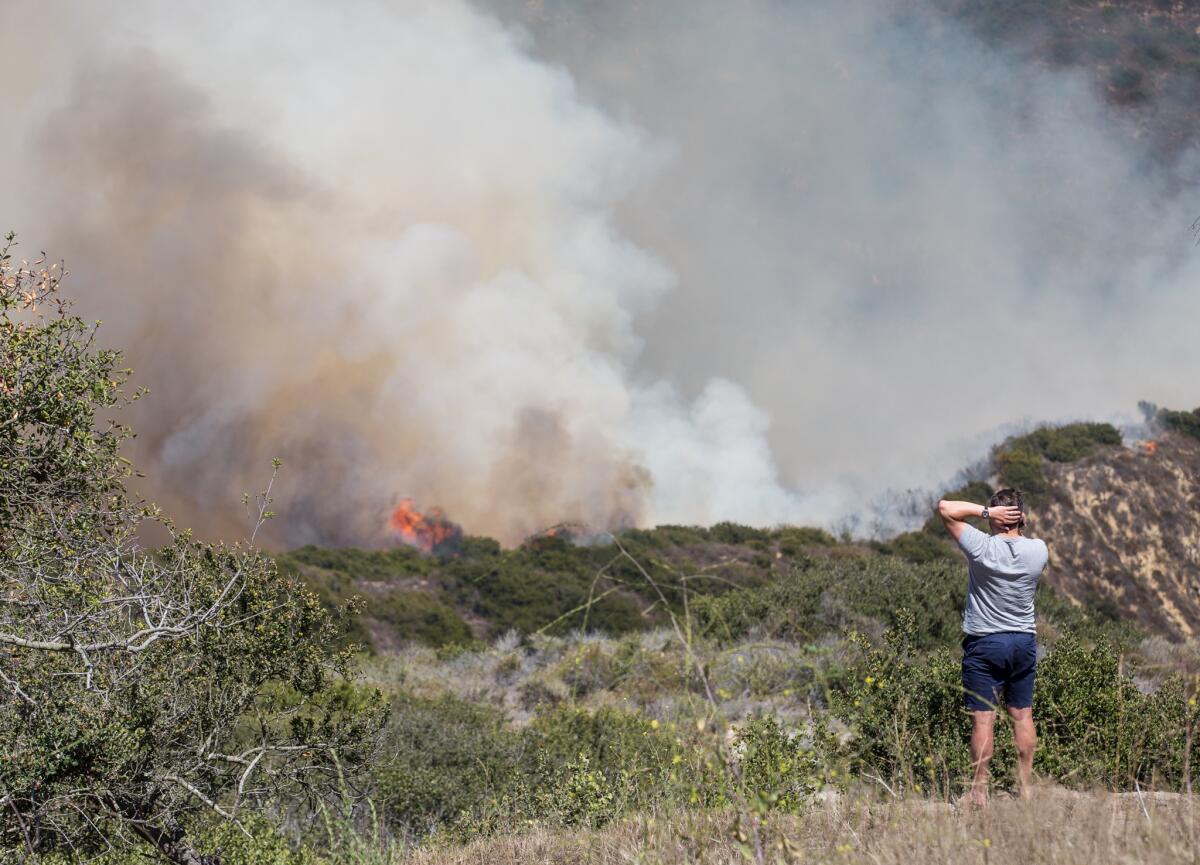Laguna Beach to consider spending $23 million to prevent and prepare for wildfires

- Share via
With several fires in local history, and last year’s Camp and Woolsey fires in recent memory, Laguna Beach officials will consider spending nearly $23 million in the next two years on a swath of measures intended to decrease the city’s risk of a similar catastrophe.
Mayor Bob Whalen’s Wildfire Mitigation and Fire Safety Subcommittee released its much-anticipated report last week after a seven-month research operation that took members to Paradise to survey the ruins of November’s Camp fire.
As expected, the 132-page flipbook delivered a dire report on Laguna’s wildfire risk, which Cal Fire designates as very high.
But officials paired the warnings with almost 50 recommendations for reducing risk and getting people to safety in the event of an emergency. In total, the subcommittee recommended the city spend $168.2 million in the next five or more years.
Protecting lives and saving some of Laguna Beach’s $16 billion in property is worth the cost, Whalen said.
“Nothing in life is free,” he said. “If you want to be safe, the reality is, it’s going to cost more money.”
A chunk of the actions — 29 recommendations geared toward expanding outreach and emergency alerts, increasing “fuel modification” efforts, undergrounding power lines along Coast Highway and refining evacuation plans — are designed to take place in the next two years for $22.9 million.
“We realized that, `OK,notifying and getting people out is probably the best thing we can do,’” said Councilwoman Sue Kempf, who also participated on the subcommittee. “Those are things that we can do that are probably the most practical and the most expeditious.”
The subcommittee will present the report to the City Council on Tuesday along with a few requests to cover about $6.9 million in short-term expenses from various city funds, redirected pension contributions and the annual hotel tax.
The remaining $16 million of short-term costs is covered by already approved funding sources, according to the report, including $10 million in undergrounding credits purchased from other cities, $4.7 million from a state grant and almost $1.3 million of “potential water district funding.”
“We’re going to spend a lot of money,” Kempf said. “I think if you’re a council member and you know you have a risk and you know you can mitigate the risk, you have to take some action. You can’t just hope it doesn’t happen here.”
The city is no stranger to disaster. In 1993, a devastating fire ripped through town, destroying 441 homes and consuming 14,000 acres.
Last year, a brush fire broke out below the Top of the World neighborhood and tore through 175 acres. Another fire in 2015 threatened Laguna Canyon and burned through 15 acres but did not destroy any structures.
With 16,000 acres of hilly, open terrain and vegetation — fields that a wind-fueled wildfire could rapidly tear through — overhead utilities, older buildings, about 6 million visitors per year and only three routes out of town, Laguna Beach could be ripe for another emergency. The city’s need to fortify ahead of a possible wildfire is urgent, according to the subcommittee.
Much of the fire safety work will have to come directly from residents, Whalen said.
“This is going to be a partnership between what the city can do with its infrastructure and vegetation management and all the things we can control,” Whalen said. “But the local residents need to look at their own homes and see if there’s a way they can harden them and ... lower their own fire risk on their property. It’s going to be a sort of dual effort.”
After the 1993 blaze, the city took measures to prevent another such catastrophe, including expanding its fuel modification zones — which includes goat grazing and hand-clearing fire-hazard vegetation — and mandating fire-retardant roofs.
But while the city pulled its weight to improve fire preparedness and educate the public, many residents did not take precautions seriously, according to Ken Frank, who served as Laguna’s city manager when the 1993 fire destroyed his home on Skyline Drive.
“I am absolutely surprised at how often the homeowner doesn’t pay any attention,” Frank said. “You can do so much to people, but they have to do something for [themselves].”
Financing the $135.8-million long-term goals is “the big nut to crack,” Whalen said.
The report cites grant programs and the possibility of tax and parking fee increases as funding sources. The subcommittee’s long-term goals for five or more years down the road are to underground utilities on Laguna Canyon Road — an estimated $120-million project — and Glenneyre Street and to improve water systems throughout town.
Whalen and Kempf emphasized the need to make Laguna Canyon Road fire-ready, as it is one of just three ways out of town.
“Paradise had four, and that wasn’t enough,” Whalen said. “We need three.”
The subcommittee’s presentation will take place at 6 p.m. Tuesday in the City Council chamber, 505 Forest Ave.
All the latest on Orange County from Orange County.
Get our free TimesOC newsletter.
You may occasionally receive promotional content from the Daily Pilot.




